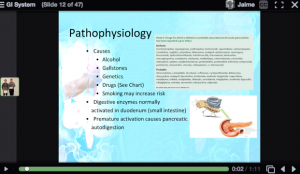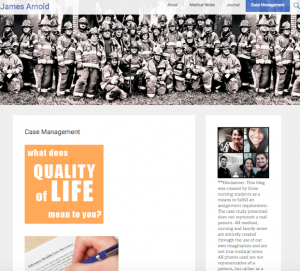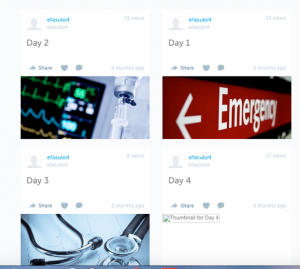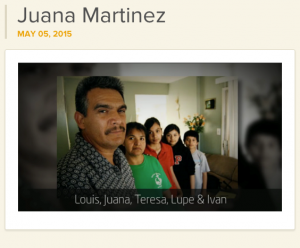When an assignment offers students an opportunity to demonstrate learning through creativity, peer and small group collaboration, integration of technology of choice, and learning by sharing, aligning with student learning outcomes becomes simple. Digital storytelling as a strategy can provide evidence of the integration of complex to simple concepts learned within the discipline, while requiring the students to build upon prior course learning. Digital Storytelling tells a story in a powerful way by connecting ideas, narratives, and emotion through the use of digital tools. These stories may evoke feelings, convey a message, describe experiences, or express a point of view.
Although digital storytelling was originally made popular in communications and creative writing courses in higher education, it has potential across diverse fields of study (Levine and Alexander, 2008; McLellan, 2006). Digital storytelling engages students through the use of technology, offering multiple modes of learning (e.g. visual and auditory), connecting the use of technology to institutional learning, and facilitating an alternative method for student assessment (Chisholm and Trent, 2013; France and Wakefield, 2011). Peer to peer collaboration and student choice for the technology used for the delivery of the story offer additional benefits. Digital storytelling integrates content in a realistic and memorable way for students, through telling and listening to stories while beginning to cultivate digital literacy skills (Smalkoski, Buturian, and Spicer, 2017).
Link to example artifact(s)
In a senior undergraduate-nursing course, students typically had been asked to present a small group presentation at the end of the semester focused on system-based content, disease process, and nursing interventions. Students were asked to present a case study aligning with the content as part of the presentation, however nearly all presentations were delivered in power point with one or two slides dedicated to the ‘case study’ portion. There was a lack of student engagement, excitement, and collaboration from one group presentation to another, leading me to explore a new strategy, Digital Storytelling.
Artifact 1. DST Guidelines and Instruction Page
The entire group presentation assignment underwent a vital makeover. At the start of the semester, students enrolled in a medical-surgical course were randomly assigned into small groups of three to four students. The groups had an opportunity to sign up for one general physiological system of choice, as long as all options were addressed. The Digital Storytelling Project spanned over the entire semester, with strategically planned steps throughout the semester. This design offered student opportunities for collaboration throughout the process, and short attainable goals to achieve. Students were asked to create a group contract determining the group roles, plan of action, and division of workload. There were two larger steps of the project:
1. VoiceThread Content: Students were required to prepare a VoiceThread presentation (audio-video recorded presentation) focused on the disease process the digital story ‘patient’ would present with. The idea was that nursing students would need to start thinking about the project early in the semester and have the knowledge and preparatory information necessary for adequate care of the patient. This portion of the assignment was due where it aligned with course content. Since students selected their topic, they were aware of and in control selecting that topic, based interest and due date convenient to their group. members. This first portion of the assignment offered a method of assessment to content delivery and presentation using VoiceThread. In addition, it aligned with the classroom content delivered to link significance to classroom learning, therefore many students utilized these student-developed content as exam review.
Artifact 2. Voice Thread Example

2. The Story: Students were required to tell a comprehensive “case study” of a patient using any medium or digital tool of their choice, such as VoiceThread, Animoto, WordPress, or other digital tool. The last day of class was reserved for in-class presentations to tell their final Digital Story. Students were empowered by having control over the creativity of the project and selecting the content delivery of choice. The guidelines were unrestrained, only requesting students present an adult patient with a critical care medical-surgical disease process within the topic selected, including a case management issue. The students were encouraged to reflect on their prior clinical experience with patients and consider how complex a patient’s “story” might be, and what perspective of the patient story they would share. On the day of the digital story presentations, students were asked to submit a text based case study format of the patient they created, along with case study questions and answers. This was done to begin a repository of patient scenarios that could be published on the web and shared under creative commons as a future resource. During presentations, student groups collaborated to conduct peer-to-peer evaluations in support of one another.
Artifacts 3. 4. 5. Examples of Student Final DTS



The depth and creativity of the digital stories were amazing. Students were creating and cultivating resources from their knowledge, rather than consuming and regurgitating information. Student choice in the design and delivery of the story, along with motivation to have their efforts shared in the future seems to have effectively increased student engagement as compared to the traditional slide presentations. Students obviously demonstrated their learning. To create a patient with an unfolding story through an illness, with symptoms, appropriate lab results, correctly aligned medications, and a creative story about who they are required high level understanding of nursing content. Learning outcomes were clearly met with this strategy. Digital storytelling could be used with any discipline to demonstrate content-based knowledge, and transferred to a real scenario or situation within that field of work.
Link to scholarly reference(s)
Chisholm, J. S., & Trent, B. (2013). Digital storytelling in a place-based composition course. Journal of Adolescent & Adult Literacy, 57 (4), 307-318. DOI 10.1002/jaal.244
France, D. & Wakefield, K. (2011). How to produce a digital story. Journal of Geography in Higher Education, 35 (4), 617-623. https://doi.org/10.1080/03098265.2011.560658
Levine, A., & Alexander, B. (2008, Oct 23). Web 2.0 storytelling: Emergence of a new genre. Educause Review, 43 (6). Retrieved from https://er.educause.edu/articles/2008/10/web-20-storytelling-emergence-of-a-new-genre
McLellan, H. (2007). Digital storytelling in higher education. Journal of Computing in Higher Education, 19 (1), 65-79. https://doi.org/10.1007/BF03033420
Smalkoski, K., Buturian, L., & Spicer, S. (2017). Using digital storytelling to transform learning. Inside Higher Ed. Retrieved from https://www.insidehighered.com/digital-learning/views/2017/08/16/using-digital-storytelling-transform-learning#.WZ72S3NBvb0.twitter
Citation
Hannans, J. (2017). Foster creativity, collaboration, and student choice using digital storytelling. In B. Chen, A. deNoyelles, & A. Albrecht (Eds.), Teaching Online Pedagogical Repository. Orlando, FL: University of Central Florida Center for Distributed Learning. https://topr.online.ucf.edu/creativity-collaboration-student-choice-using-digital-storytelling/.